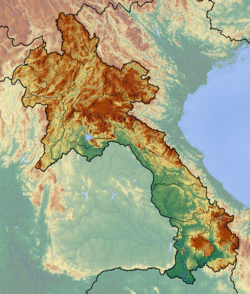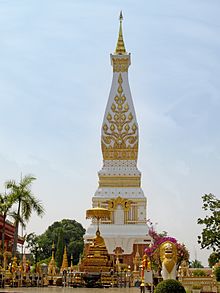Portal:Laos/Intro
Laos (/ˈlɑːoʊs/ ⓘ, /ˈlaʊs/, /ˈlɑːɒs/, or /ˈleɪɒs/; Lao: ລາວ, Lao pronunciation: [láːw], Lāo), or commonly referred to its colloquial name of Muang Lao (Lao: ເມືອງລາວ, Muang Lao), is a landlocked country in the heart of the Indochinese peninsula of Mainland Southeast Asia, bordered by Myanmar (Burma) and China to the northwest, Vietnam to the east, Cambodia to the southwest, and Thailand to the west and southwest. It traces its historic and cultural identity to the kingdom of Lan Xang Hom Khao (Kingdom of a Million Elephants Under the White Parasol), which existed for four centuries as one of the largest kingdoms in Southeast Asia. Due to Lan Xang's central geographical location in Southeast Asia, the kingdom was able to become a popular hub for overland trade, becoming wealthy economically as well as culturally. After a period of internal conflict, Lan Xang broke off into three separate kingdoms — Luang Phrabang, Vientiane, and Champasak. In 1893, it became a French protectorate, with the three territories uniting to form what is now known as the country of Laos. It briefly gained freedom in 1945 after Japanese occupation, but was recolonised by France until it won autonomy in 1949. Laos became independent in 1953 under King Sisavang Vong. The capital city is Vientiane. Other large cities include Luang Prabang, Savannakhet, and Pakse. The official language is Lao. Laos is a multi-ethnic country with the politically and culturally dominant Lao people making up approximately 60 percent of the population, mostly in the lowlands. Mon-Khmer groups, the Hmong, and other indigenous hill tribes, accounting for 40 percent of the population, live in the foothills and mountains. Laos' ambitious strategies for development are based on generating electricity from its rivers and selling the power to its neighbors, namely Thailand, China, and Vietnam, as well as its initiative to become a 'land-linked' nation, shown by the planning of four new railways connecting Laos to those same countries. This, along with growth of the mining sector, Laos has been referred to as one of East Asia and Pacific's fastest growing economies by the World Bank, with annual GDP growth averaging 7% for the past decade. It is a member of the Asia-Pacific Trade Agreement (APTA), Association of Southeast Asian Nations (ASEAN), East Asia Summit and La Francophonie. Laos became a member of the World Trade Organization (WTO) in 2013. Selected article -Lao script or Akson Lao (Lao: ອັກສອນລາວ [ʔák.sɔ̌ːn láːw]) is the primary script used to write the Lao language and other minority languages in Laos. Its earlier form, the Tai Noi script, was also used to write the Isan language, but was replaced by the Thai script. It has 27 consonants (ພະຍັນຊະນະ [pʰā.ɲán.sā.nāʔ]), 7 consonantal ligatures (ພະຍັນຊະນະປະສົມ [pʰā.ɲán.sā.nāʔ pā.sǒm]), 33 vowels (ສະຫລະ/ສະຫຼະ [sā.láʔ]), and 4 tone marks (ວັນນະຍຸດ [wán.nā.ɲūt]). The Lao abugida was adapted from the Khmer script, which itself was derived from the Pallava script, a variant of the Grantha script descended from the Brāhmī script, which was used in southern India and South East Asia during the 5th and 6th centuries AD. Akson Lao is a sister system to the Thai script, with which it shares many similarities and roots. However, Lao has fewer characters and is formed in a more curvilinear fashion than Thai. (Full article...)General images -The following are images from various Laos-related articles on Wikipedia.
Related portalsSoutheast Asia Other Countries Selected biography -Photisarath (also spelled Phothisarath, Phothisarat, or Potisarat, Lao: ພະເຈົ້າໂພທິສະລາດ, 1501–1547), son of King Visoun of Lanxang, is considered to be the most devout of the Lao kings. He banned spirit worship and built temples upon the sites of spirit shrines. His elephant fell and crushed him while he sought to display his prowess to the diplomatic corps. His son Setthathirath returned from Chiang Mai to succeed him to the throne of Lan Xang. Phothisarath was ruler (1520–47) of the Lao kingdom of Lan Xang whose territorial expansion embroiled Laos in the warfare that swept mainland Southeast Asia in the latter half of the 16th century. King Chairachathirat of the Ayutthaya Kingdom invaded Vientiane with a large army in 1540, captured Muang Khouk and crossed the Mekong, but succumbed to a rout at the battle of Sala Kham, the remnants fleeing for their lives and leaving enormous casualties behind. Phothisarath himself allied himself with Burma, sent out 3 campaigns against the Ayutthaya Kingdom: the first to Phitsanulok in 1535, the second one to Vieng Prangarm in 1539, and third was sent in 1548 to Vieng Prab (now Sawangaburi) where he brought back 20,000 families to settle in the Lan Xang kingdom. (Full article...)Selected picture View of the Wat Xieng Thong. WikiProjects
TopicsCategoriesDid you know?
Tasks
Associated WikimediaThe following Wikimedia Foundation sister projects provide more on this subject:
ContributorsDiscover Wikipedia using portals
Purge server cache | |||||||||

































































